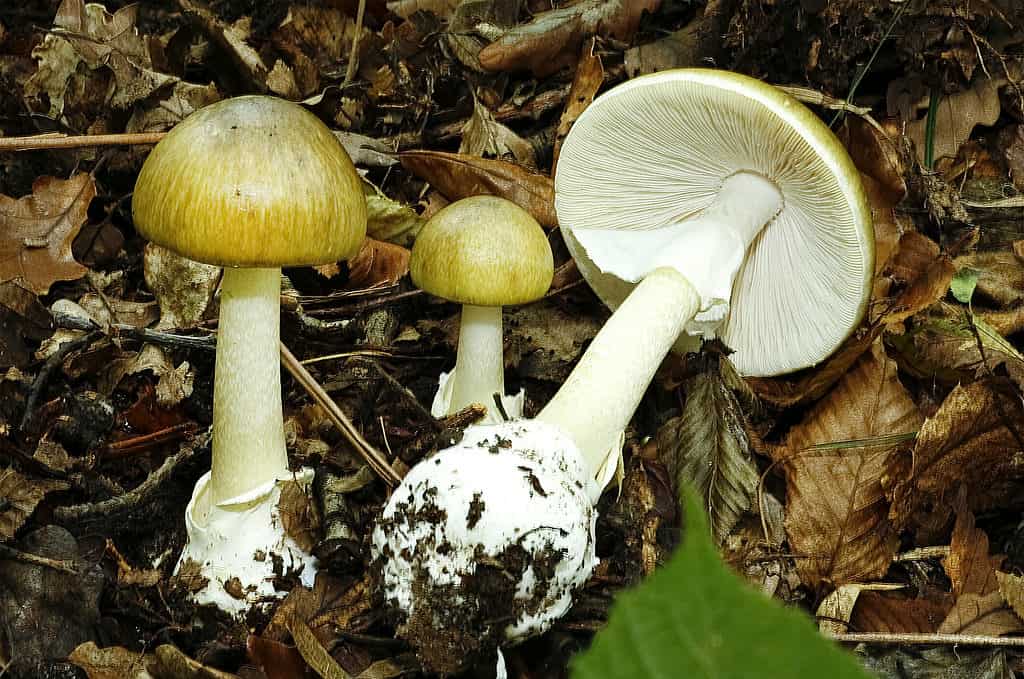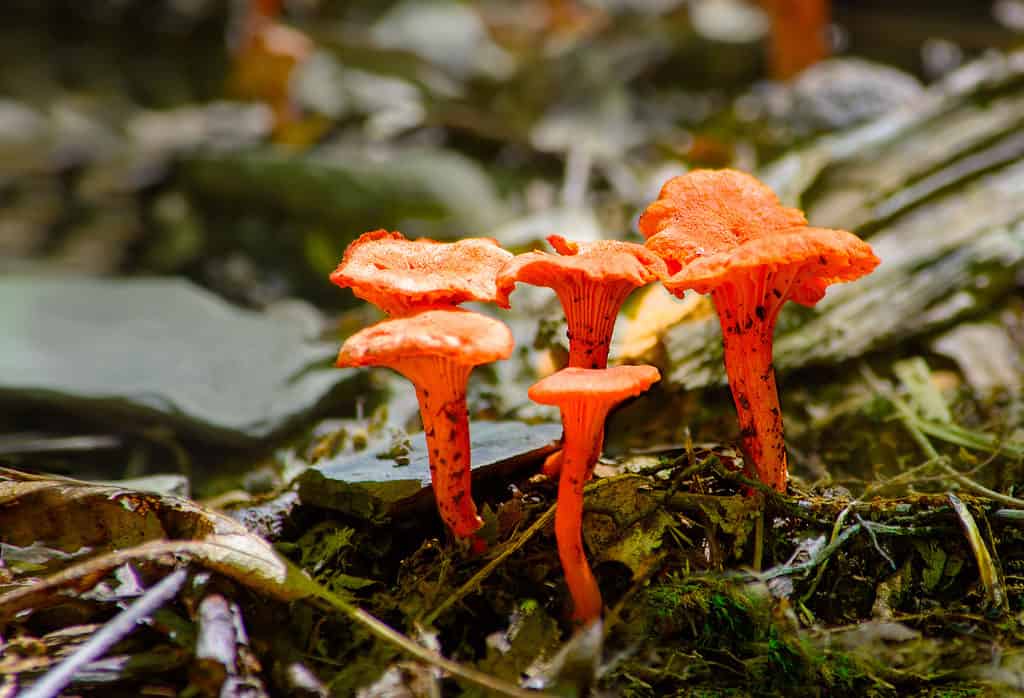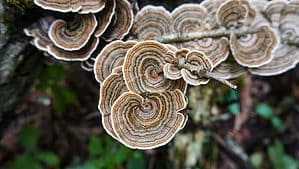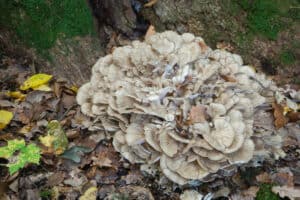If you’re interested in foraging for wild, edible mushrooms, you may be wondering if there are quick tricks of the mushroom hunting trade for knowing if a particular specimen is poisonous. You may have read guides cautioning you to stay away from mushrooms featuring certain colors or smells. So, do quick tips for identifying poisonous mushrooms have merit?
Read on to find out!
How to Tell if a Mushroom is Poisonous
You may come across comments on a forum warning a forager to keep away from red-capped or all-white mushrooms. You might also hear false claims that a mushroom that smells phenolic is always poisonous, while specimens with pleasant smells are edible. Or maybe you have heard that a mushroom that stains blue is always psychoactive. However, there’s some huge issue with these claims. Fungi are incredibly complex, diverse, and constantly evade humans’ attempts to assign black-and-white rules to their characteristics. The reality is that no quick tips can replace the necessary work of accurate identification through lab testing, thorough research with the help of dichotomous keys and expert assistance, or forays with mycologists, etc.

Accurate identification of the species is the only way to verify the edibility or toxicity of a mushroom.
©el_cigarrito/Shutterstock.com
How to Tell if a Mushroom is Poisonous: Color?
Some general rules can be useful to help beginner foragers stay clear of a particularly poisonous genus. However, there will always be exceptions to the rule, especially across multiple genera or families. For example, it is a good idea for new foragers to avoid foraging for all-white stem-and-cap mushrooms due to the number of deadly poisonous all-white and mostly-white species in the Amanita genus. However, this does not mean all-white mushrooms are always poisonous, or that coloration is an easy way to identify a poisonous mushroom in general.
You’ll also find warnings to avoid red mushrooms. In reality, there are plenty of edible red mushrooms alongside red poisonous species. The cinnabar chanterelle (Cantharellus cinnabarinus) is an example of a delicious, edible wild mushroom. In reality, the bright coloration of mushrooms does not indicate inherent toxicity. Additionally, several deadly poisonous mushroom species feature dull coloration, such as the brown-colored Galerina marginata. This caution against red mushrooms may, in part, be due to our familiarity with aposematism in animals, in which some prey animals use bright, flashy coloration as a defense to signal their toxicity or dangerousness to potential predators. Warnings against red mushrooms in general may also be linked to the well-known, often red-capped, and psychoactive Amanita muscaria.
Another common refrain is to avoid blue-staining mushrooms because they contain psychoactive chemicals. While psilocin-containing mushrooms do often stain blue, there are other non-psychoactive chemicals that cause blue staining to occur in mushrooms. Many species in the Boletales order of mushrooms stain blue. A number of them are edible, such as the cornflower bolete (Gyroporus cyanescens). For some boletes, oxidized gyrocyanin is the source of this blue staining.

Entirely red, the cinnabar chanterelle (
Cantharellus cinnabarinus) is an excellent edible mushroom.
©K Quinn Ferris/Shutterstock.com
How to Tell if a Mushroom is Poisonous: Smell?
Some mushrooms smell delightfully fruity, almondy, nutty, or earthy. Others may have a fishy, rancid, or phenolic smell that is quite off-putting. While many poisonous mushrooms can smell horribly chemically, others have a quite mild and even pleasant odor.
Within some genera of mushrooms, smell and taste tests can aid in identification, but this is certainly not a universal truth in mushroom hunting. The smell may help distinguish edible from inedible species in the Agaricus genus, but this is only one part of systematic identification. Within this particular genus, inedible species do tend to smell phenolic and may stain yellow (eg. Agaricus xanthodermus), while edible species often feature a mild or almondy smell and may stain pink or red (eg. Agaricus sylvaticus).
However, if you generalized this particular smell test for species in the Agaricus genus to try to determine edibility across any mushroom genus, you could end up ingesting a deadly poisonous species. In fact, ingestion of Amanita phalloides is linked to the majority of mushroom-related human fatalities in the world, and when it is fresh and young, this species reportedly smells mild and honey-sweet. On the flip side, several species of stinkhorn mushrooms, despite their smell, are actually edible.

Stinkhorn mushrooms get their name for a good reason, but some are actually considered edible.
©Edvard Mizsei/Shutterstock.com
How to Tell if a Mushroom is Poisonous: Taste?
Some foragers use a taste test to aid in the identification of certain species. This test involves chewing a tiny piece of the raw mushroom with your front teeth. Then, you taste the piece with the tip of your tongue and spit it out. Some people also swish and spit a few swigs of water for good measure afterward. A generalized statement about taste tests claims that if the raw mushroom tastes peppery or strongly bitter, then it’s poisonous.
However, like the rest of the above claims for supposedly quickly identifying a poisonous mushroom, this statement is not universally true. Even Russula emetica, known as the sickener in North American guides, is routinely prepared and consumed without ill effects in other regions of the world. This mushroom tastes strongly peppery when raw, and many reports exist of GI distress after consumption. However, some mycologists believe the issue with consuming R. emetica arises when one does not thoroughly cook or pickle it. Cultures that routinely use R. emetica in their cuisine practice parboiling or pickling methods that degrade the chemicals associated with the peppery and bitter taste and subsequent GI distress.
And, of course, some deadly poisonous species aren’t peppery at all. According to those who have survived an amatoxin poisoning, Amanita phalloides reportedly taste quite mild raw and apparently delicious when cooked, but it can cause fatal liver and kidney failure within a few days of ingestion- no matter how thoroughly you cook it. Ultimately, accurate identification of a mushroom and referencing reputable research on the species is crucial to understanding its edibility.

Many inedible mushroom features are off-putting.
©khlungcenter/Shutterstock.com
The photo featured at the top of this post is © gvictoria/Shutterstock.com
The information presented on or through the Website is made available solely for general informational purposes. We do not warrant the accuracy, completeness, or usefulness of this information. Any reliance you place on such information is strictly at your own risk. We disclaim all liability and responsibility arising from any reliance placed on such materials by you or any other visitor to the Website, or by anyone who may be informed of any of its contents. None of the statements or claims on the Website should be taken as medical advice, health advice, or as confirmation that a plant, fungus, or other item is safe for consumption or will provide any health benefits. Anyone considering the health benefits of particular plant, fungus, or other item should first consult with a doctor or other medical professional. The statements made within this Website have not been evaluated by the Food and Drug Administration. These statements are not intended to diagnose, treat, cure or prevent any disease.
Thank you for reading! Have some feedback for us? Contact the AZ Animals editorial team.







